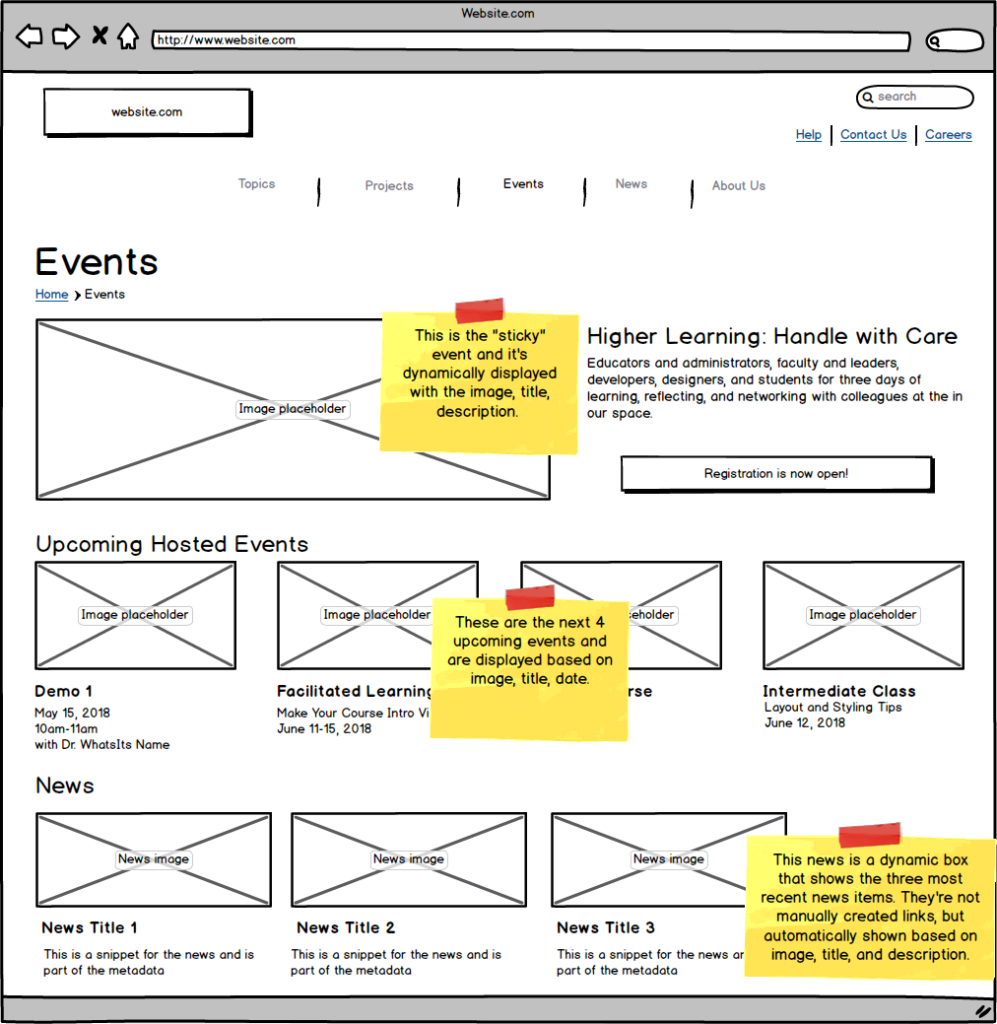One thing that’s been around for a while but is rarely taken advantage of (at least on the digital property projects that I’ve come across) is dynamic content display. Maybe it’s poorly understood, but it’s an easy concept to grasp and, quite frankly, can feel very liberating. When we explain the concept to clients, they typically respond with, “Yes, that’s what we need. That’s what we’ve been waiting for. Where have you been all my life? You had me at hello!!”
What is Dynamic Content Display?
Plain and simple, dynamic content display is content on your site that (once you set it up) automatically appears without you or your content creators manually adding in the links or images or snippets of text. Many older websites will have what I call “manually curated” links or snippets. For example, you might have a content page that has a list of related links and you create this list manually. Dynamic content display is the opposite of this: you tell your CMS (content management system) what you want to appear in that box based on metadata and taxonomy, and the CMS does it for you. You don’t have to make sure the list is continually kept up to date.
Why Is It Useful?
Setting up dynamic content display on your site is useful because it allows your digital property to operate through set rules instead of manual curation. Dynamic content display:
- Helps ensure consistency on your site. Not even the best web editor can keep up with manually setting and updating links on a website. If your website has more than 50 pages, pretty soon people will start forgetting where links are set, links become broken, or they’re not kept up to date.
- Makes for a scalable approach to website management. With 400, 1000, or 10,000 pages or across a web team with more than one editor or author, moving away from manually curated lists ensures consistency, cuts down on maintenance effort, and ensures that interconnected content is shared across the site.
- Provides a “set it and forget it” approach to how and where content is displayed on your site. For each page, you only decide once what is supposed to appear in a certain section on a website, you set it up, and it is automatically updated.
How Does It Work? How Is It Set Up?
One of the easiest examples that many people can relate to is dynamic content display for news and events. In this wireframe, all the content is dynamically built.

With taxonomy, the possibilities are endless:
- A city might want to create a dynamically generated page that lists everything about specific communities within the city (garbage, water, sewer, rec centres, events, news, schools, parks) and it’s easier to maintain this through taxonomy than manual curation.
- A hospital/HMO/healthcare provider might want a page that lists all their locations of a certain type: Where are the labs? Which ones do lactose intolerance or celiac testing? Which locations have Naloxone training? Where can you see a confidential mental health counselor?
- A product company might target certain products for certain industries. On the industry pages, the relevant products can be automatically displayed. If the product is removed from market, the content is archived and removed from all the pages where it was mentioned.
There are a few components that go into making this work:
- Your pages need to be labeled as news, events, or other specific types of content
- You need to have metadata and taxonomy set up to accept information in separate fields not as one big glop of information
- Your website needs to be structured to query the content metadata and taxonomy, instead of allowing an “anything goes” manual approach to creating pages.
(And of course, I think the pitch for “hire me!” comes here. To get this set up properly, you’ll need to do some user research, business needs analysis, site structure development with IA, metadata, and taxonomy, then put IT resources toward updating your digital properties.)
How Does It Help Meet Business Goals?
Clients looking for a more scalable and consistent solution have usually encountered issues like:
- Links are out of date and it’s hard to keep the website up to date
- The website needs too many staff to maintain and their skills can be put to use elsewhere
- Promoting products, services, or information around the site happens on an ad hoc basis and the business is looking for stronger, more consistent relationships and promotion of content
- The business needs to be able to promote all relevant content without having one person aware, and able to curate, of all the content
- The business wants to progress in the digital maturity model
What Are Some Caveats?
Well, the caveats are that you have to do work to achieve dynamic content display. Nothing good comes without work, amiright? You’ll need to align the business around the strategic goals that dynamic content display supports, then create the structure to support dynamic content.
Never Look Back
Having said this, I’ve never had a client that has looked back and said, “I wish we stayed with manually curated content. I loved fixing broken links. I loved it when stakeholders complained that their link wasn’t in the right spot. And I especially loved how other people would create content that I didn’t know about so I couldn’t link to it.”
Here’s my call to action: Do it because it’s super cool. Do it because you’ll save time and money. Do it because it’s fun. Do it for your sanity.
